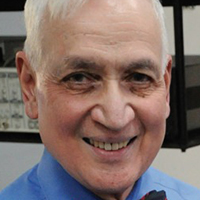C. Kumar N. Patel
Chandra Kumar Naranbhai Patel is an electrical engineer. He developed the carbon dioxide laser in 1963; it is now widely used in industry for cutting and welding, as a laser scalpel in surgery, and in laser skin resurfacing.
There are many types of lasers that vary in strength, efficiency and utility. Because the atmosphere is quite transparent to infrared light, CO2 lasers are also used for military range finding using LIDAR techniques.The CO2 laser has more practical applications today than any other type of laser. It has improved high-resolution and saturation spectroscopy and contributed to laser-induced fusion and nonlinear optics. In medicine, its primary use is in laser surgery, including the removal of tumors and various noncontact and noninvasive procedures, and is used in weather prediction, communications, and military applications.
C. Kumar N. Patel was born in Baramati, India in 1938. He received his bachelor’s degree in Telecommunications from Poona University at the age of 19 (1958) then came to the U.S. for graduate school. In short order, he earned an MS (1959) and PhD (1961) in Electrical Engineering from Stanford University. Patel joined the Bell Laboratories in 1961. Where he eventually held the title of Executive Director, Research, Materials Science, Engineering and Academic Affairs Division at AT&T Bell Laboratories, Murray Hill, NJ, USA. Patel’s discovery, in 1963, of the laser action on the vibrational-rotational transitions of carbon dioxide and his invention, in 1964, of efficient vibrational energy transfer between molecules, led to his series of experiments which demonstrated that the carbon dioxide laser was capable of very high cw and pulsed power output at very high conversion efficiencies. No other laser has made a greater impact on society.
In 1966, Patel began pioneering studies which created a new field of infrared nonlinear optics which led to his 1969 invention of the spin-flip Raman laser, a class of tunable infrared lasers and the first tunable Raman laser in any wavelength region. Using this laser, he carried out very high resolution spectroscopy of both ground and vibrationally-excited states of molecular gases, resulting in his contribution to the problem of atmospheric pollution detection. In 1970, he developed a tunable laser opto-acoustic measurement technique for extremely small concentrations of pollutant gases. In 1973, he carried out the first measurements of the temporal variation of concentration of nitric oxide in the stratosphere, which provided crucial data bearing on the problem of ozone depletion by man-made nitrogen oxide emission from sources such as the SST. His opto-acoustic spectroscopy studies of cryogenic liquids and solids, begun in 1980, are providing crucial data in understanding these materials and have culminated in the first observations of high vibrational overtone absorption of molecular hydrogen in solid hydrogen. Patel’s current research interests include spectroscopy of highly transparent liquids and solids, and surgical and medical applications of carbon dioxide lasers.
From 1993-1999, Patel served as Vice Chancellor for Research at the University of California, Los Angeles, where he was also Professor of Physics and Adjunct Professor of Electrical Engineering. Today, he works for Pranalytica Inc. in Santa Monica, CA, USA.
In 1996, President Bill Clinton awarded Patel the National Medal of Science, “[f]or his fundamental contributions to quantum electronics and invention of the carbon dioxide laser, which have had significant impact on industrial, scientific, medical, and defense applications. In addition to the carbon dioxide laser, he also developed the “spin-flip” infrared Raman laser.

C. Kumar N. Patel
Date of Birth: 02 Jul 1938
Birth Place: Baramati
Proffession: Electrical engineer
Nationality: Indian


